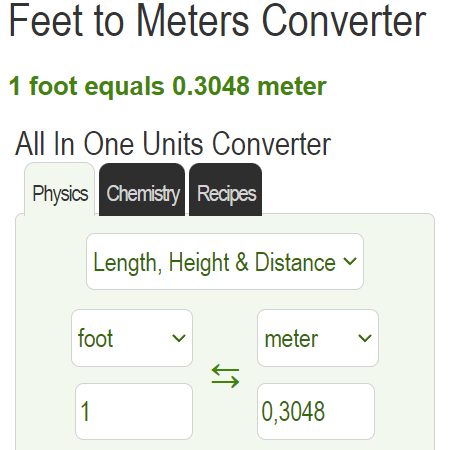1.8 m to inches
1.8 m are equal to 70.8661 inches
m To Inch Converter
| ⇆ | ||
|
|
||
|
🔗 Help our site grow by sharing it!
|
||
To find the value in meter that corresponds to a value in inches, multiply the value in m by 39.3701 (the conversion factor). Here is the Conversion formula
Value in inches = value in m × 39.3701
Let's say that you have 1.8 m and you want to convert it to inches. By using the conversion formula provided above, you get:
Value in inch = 1.8 × 39.3701 = 70.8661 inches
This conversion formula works because one inch is equal to 0.0254 m.
To convert a different value in m, simply replace the value in the formula above with the new value.
What is the Relationship Between M and Inches
The Exact Relationship is Defined as follows:
1 inch = 0.0254 m
This means that to convert a measurement from m to inches, you multiply the value in m by 0.0254.
Using The Calculator
Here is how to switch from m to inches:
- Determine the measurement in m that you are working with: For this example, let's use
1.8 m. - Apply the formula: Multiply the value in m by 39.3701:
Value in inches = 1.8 × 39.3701 - Perform the calculation: Youmay use want to use a calculator or do the math:
Value in inches = 70.8661 inches - Round the result: Depending on your needs, round the result to three decimal places:
1.8 m ≈ 70.866 inches
Quick Tips For Mental Math
If you don't have a calculator handy, or you want to do a quick mental estimate, you can approximate:
- Use 39.4 instead of 39.3701 for a rough estimate.
- For example:
- 1 m ≈ 39 inches, (39.3701, exactly)
- 2 m ≈ 79 inches, (78.7402, exactly)
- 3 m ≈ 120 inches, (118.11, exactly)
Conclusion
You've learned how to convert m to inches and vice versa! Use the formula inches = m ÷ 0.0254 for accurate results, or approximate using quick mental math for a rough estimate.
Common Questions This Converter Can Answer
Basic Conversions
- How many m are in 1.8 inches?
- 1.8 m are equal to how many inches?
- What is 1.8 m in inches?
Conversion Methods
- How do I convert from m to inches?
- What is the conversion factor between m and inches?
- What formula should I use to convert m to inches?
Practical Applications
- How do I measure m in inches?
- What's the equivalent of 1.8 m when expressed in inches?
- How can I convert between m and inches for my project?
Common Conversions
- What is 1 m in inches?
- How much is 10 m in inches?
- What's half a m in inches?
Professional Use
- How do I convert m to inches in technical documentation?
- What's the precise conversion rate from m to inches?
- How do international standards convert between m and inches?
Definition of Meter
A meter (m) is the fundamental unit of length in the International System of Units (SI). It is defined by taking the fixed numerical value of the speed of light in vacuum (c) to be 299,792,458 when expressed in the unit m/s. This modern definition, established in 1983, ensures that the meter is standardized through universal physical constants. The meter is used worldwide in science, industry, and everyday measurements. In practical terms, a meter is slightly longer than a yard, being approximately 39.37 inches. This unit is essential in construction, engineering, athletics, and countless other applications. The meter's subdivisions (centimeters, millimeters) and multiples (kilometers) form the basis of the metric system used globally.
Definition of Inch
An inch (in) is a fundamental unit of length in both the United States customary system and the British imperial system of measurement. Precisely defined as exactly 25.4 millimeters since 1959, the inch has a rich history dating back to ancient measurements based on the human body. One inch was traditionally represented by three barleycorns placed end to end. In modern usage, inches are predominantly used in the United States, Canada, and the United Kingdom for various applications including:
- Screen and display sizes (televisions, monitors, smartphones)
- Construction materials and hardware
- Plumbing fixtures and pipe diameters
- Tire dimensions
- Paper sizes (such as 8.5 × 11 inches)



